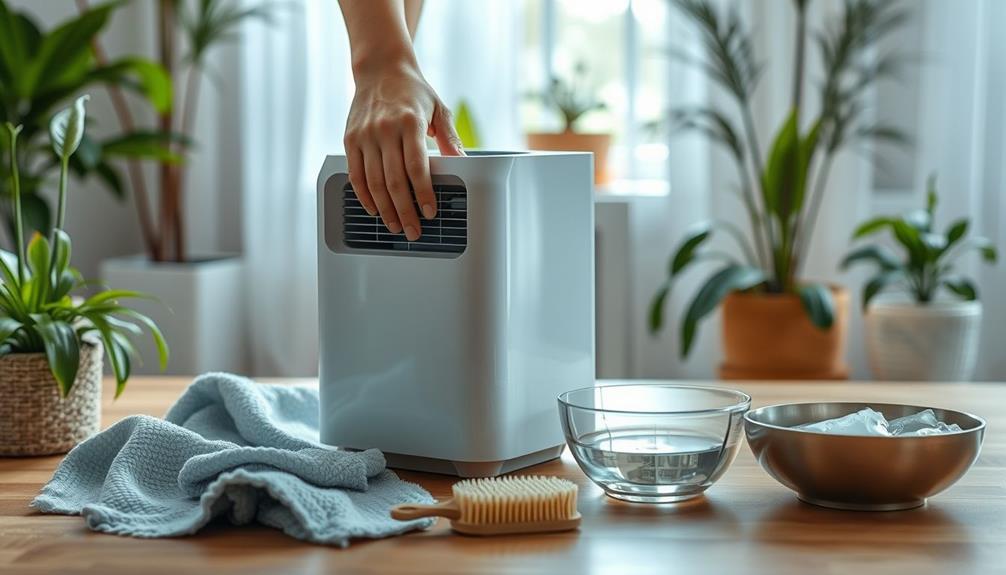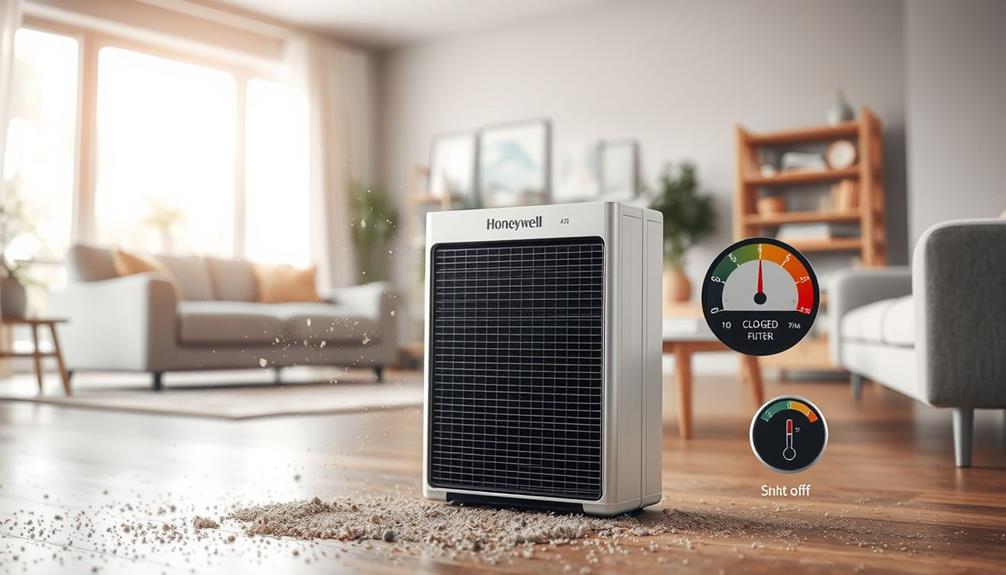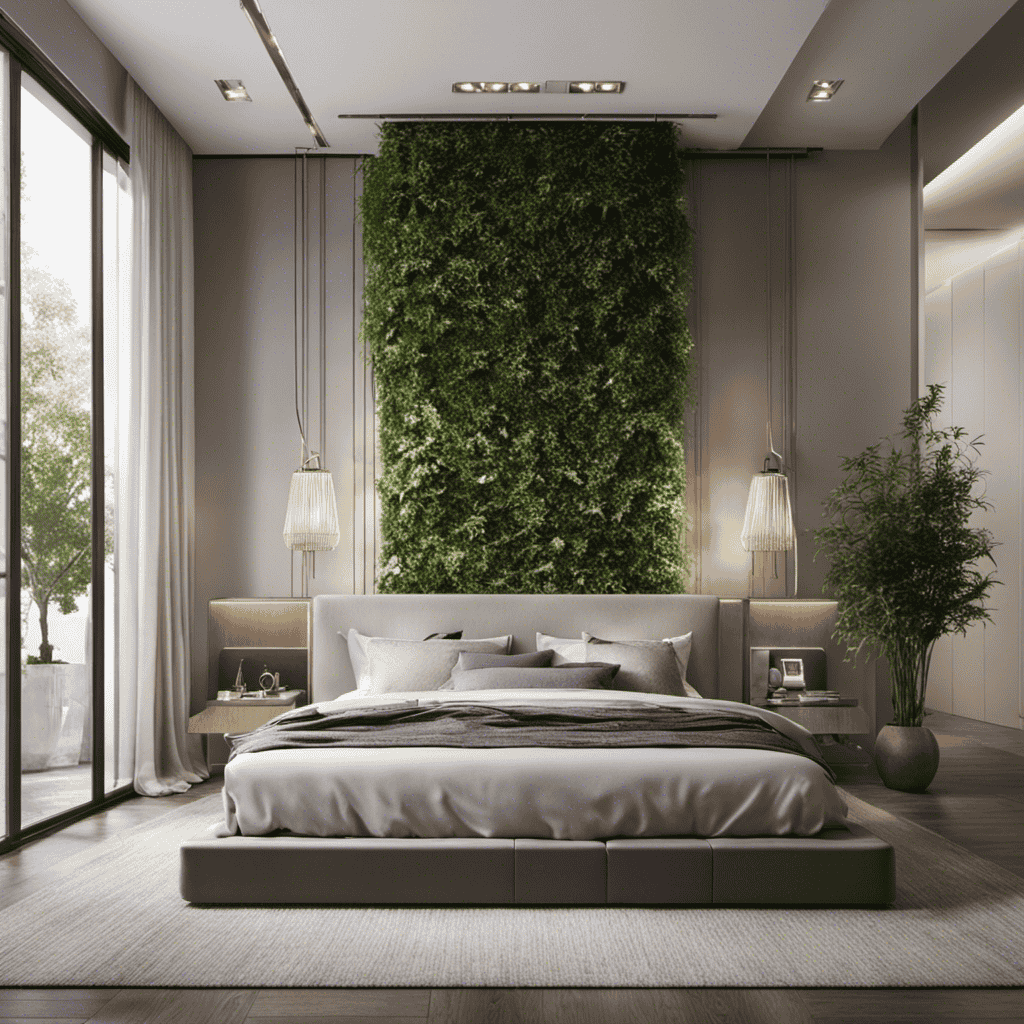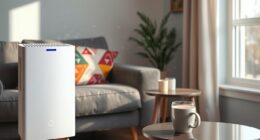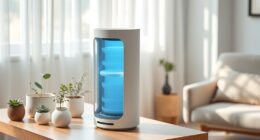To clean your air purifier without causing damage, start by unplugging it to avoid shock. Check the filters; if you have a washable HEPA filter, rinse it under lukewarm water without using harsh detergents. Let it dry completely before reinserting. For disposable filters, replace them every 3 to 6 months, following the manufacturer's guidelines. Use a vacuum with a brush attachment to gently clean dust from the unit's interior and exterior. Keep in mind some common mistakes that could hinder performance. You can find more tips to enhance your air purifier's efficiency and longevity.
Key Takeaways
- Always turn off and unplug the air purifier before starting any cleaning to prevent electric shock.
- Use a vacuum with a soft brush attachment to gently clean filters without causing damage.
- Rinse washable HEPA filters under lukewarm water, avoiding detergents that can degrade materials.
- Handle disposable filters carefully to prevent bending or breaking components during removal and replacement.
- Follow the manufacturer's guidelines for cleaning and replacing filters to maintain optimal performance and warranty coverage.
Importance of Regular Cleaning
Maintaining your air purifier through regular cleaning is essential for ideal performance and air quality. Indoor air can be 2-5 times more polluted than outdoor air, so neglecting the cleaning process can lead to health issues like respiratory diseases and headaches. Ozone air purifiers, for instance, can effectively eliminate allergens and odors, making regular maintenance even more important to guarantee they function correctly air quality indicators.
By committing to regular maintenance, you confirm your air purifier effectively reduces allergens and maintains optimal air quality.
Monthly cleaning is vital to prevent clogging of filters, which can greatly hinder efficient airflow. When filters become dirty, your purifier struggles to work at its best, ultimately decreasing its effectiveness. This is especially essential for individuals with asthma or allergies, as poor indoor air quality can exacerbate their conditions.
Moreover, a consistent cleaning schedule not only enhances purification effectiveness but also helps extend the lifespan of your device. By keeping your air purifier in top shape, you're investing in better health for yourself and your family.
Cleaning Washable HEPA Filters

Cleaning your washable HEPA filters is vital for maintaining your air purifier's performance.
Regular upkeep can greatly enhance your air quality, making it essential to establish a cleaning routine.
To get the best results, you'll want to follow the proper washing steps and drying tips.
For instance, using a range of services offered can help you identify the best cleaning practices for various home appliances.
Regular cleaning every 3 to 6 months can help keep dust and allergens at bay, ensuring your home stays fresh and healthy.
Importance of Regular Cleaning
Regularly cleaning your washable HEPA filters is vital for keeping your air purifier working at its best. By maintaining these filters, you guarantee they capture up to 99.97% of airborne particles like dust, pollen, and mold. This regular cleaning routine, recommended every 3 to 6 months, is particularly important if you have allergy sufferers in your home.
Neglecting this task can lead to reduced air quality, increased energy consumption, and potential damage to your air purifier from restricted airflow. Following proper cleaning guidelines is important, as not all HEPA filters are washable. Improper cleaning can void warranties and affect functionality.
Here's a quick look at the benefits of regular cleaning:
| Benefits of Regular Cleaning | Impact on Air Quality |
|---|---|
| Maintains ideal performance | Reduces airborne pollutants |
| Prevents mold growth | Improves allergy symptoms |
| Lowers energy consumption | Enhances overall health |
Steps for Proper Washing
To guarantee your air purifier continues to function effectively, you'll need to wash the washable HEPA filters properly. A clean air environment can also enhance your home security by reducing allergens and improving overall well-being, which is vital for a peaceful living space.
Start by turning off and unplugging the air purifier to confirm your safety during the cleaning process. Once it's unplugged, remove the HEPA filter according to your user manual's instructions.
Next, rinse the HEPA filter under lukewarm water. Be careful to avoid using harsh detergents or cleaning agents, as these can damage the filter and compromise its effectiveness. Instead, focus on rinsing away any dust and debris to maintain peak air purification.
For more tips on home safety, check out community perspectives on home security.
After rinsing, it's essential to let the HEPA filter dry completely in a clean, well-ventilated area. This step prevents mold growth and guarantees that the filter is ready for use when you're done washing. Make sure to avoid any dampness before reinserting it into the air purifier.
For best results, aim to wash the washable HEPA filters every 3 to 6 months. This regular maintenance helps keep your air purifier working efficiently, especially if you're an allergy sufferer.
Always consult your user manual for specific washing instructions tailored to your model.
Drying Tips for Filters
After washing your washable HEPA filter, confirming it dries properly is essential for maintaining its performance. Here are some drying tips for filters to help you out:
| Step | Action | Notes |
|---|---|---|
| 1. Rinse | Use warm water to remove soap residue | This helps maintain effectiveness. |
| 2. Air Dry | Place in a well-ventilated area | Allows the filter to air dry completely. |
| 3. Avoid Sunlight | Don't expose to excessive heat | Direct sunlight can damage materials. |
| 4. Drying Surface | Use a clean dry surface or drying rack | Facilitates even airflow during drying. |
| 5. Manufacturer's | Check the manufacturer's instructions | Some filters may have unique requirements. |
Make sure to let your HEPA filter air dry completely for at least 24 hours to prevent mold growth. Placing it in a well-ventilated area is key. Remember, a damp filter can hinder your air purifier's efficiency. Following these steps will confirm you keep your air purifier running smoothly!
Maintaining Disposable Filters

To keep your air purifier running efficiently, it's essential to replace disposable filters regularly.
Regular maintenance is key to ensuring peak performance, much like the importance of regular vet check-ups for your dogs.
You should learn safe removal techniques to avoid damaging the unit and follow proper disposal methods to help the environment.
Importance of Regular Replacement
Maintaining ideal air quality in your home hinges on the regular replacement of disposable filters in your air purifier. Typically, you should replace dirty filters every 3 to 6 months, depending on usage and air quality conditions. Following the manufacturer's guidelines for your specific air purifier model is vital for peak air purifier performance.
Regular maintenance not only guarantees cleaner air but can also help reduce symptoms related to environmental irritants, such as those experienced by individuals with asthma exacerbations.
When you neglect to replace those dirty filters, you risk decreased airflow and reduced effectiveness in trapping airborne pollutants. This can worsen your indoor air quality, defeating the purpose of having an air purifier in the first place.
Using manufacturer-approved filters is critical, as they assure compatibility and maintain the efficiency of your device.
Regular replacement doesn't just improve air purification; it also extends the lifespan of your air purifier. By preventing strain on the motor and other components, you can enjoy your purifier's benefits for a longer time.
Prioritizing this maintenance task will make a significant difference in how well your air purifier functions, keeping your home a healthier environment. So, make it a habit to monitor and replace those filters regularly for the best results.
Safe Removal Techniques
When you're ready to remove the disposable filters from your air purifier, safety should be your top priority. Start by unplugging the air purifier to avoid any risk of electric shock. It's crucial to consult the manufacturer's instructions for the correct procedure to access the front grill and remove the disposable filters without damaging any components.
Here's a quick guide to help you:
| Step | Action | Notes |
|---|---|---|
| 1. Unplug the unit | Disconnect from power | Always prioritize safety |
| 2. Remove front grill | Follow the manufacturer's instructions | Confirm you don't force anything |
| 3. Gently pull out filter | Take care not to bend or break parts | Handle with care to avoid damage |
| 4. Replace with new filter | Use only manufacturer-approved options | This helps maintain peak performance |
| 5. Clean exterior | Wipe down with a microfiber cloth | Keeps the unit in good condition |
Proper Disposal Methods
Proper disposal of disposable filters is essential for both your health and the environment. By following proper disposal methods, you can prevent harmful pollutants from affecting air quality conditions in your home.
Additionally, confirming that your air purifier is maintained regularly can help mitigate the risk of allergens and pollutants circulating in your space, as cat health and nutrition can also be influenced by air quality.
Here are some steps to verify you dispose of used filters correctly:
- Seal Them: Before disposal, place used disposable filters in a sealed plastic bag. This helps contain any trapped pollutants and allergens, preventing them from escaping into the air.
- Check Manufacturer Specifications: Always consult your air purifier's manufacturer for specific disposal instructions. Some brands offer recycling programs or may have unique disposal recommendations that enhance environmental protection.
- Follow Local Regulations: Dispose of filters in your regular household trash unless stated otherwise. Avoid incinerating them, as this could release harmful substances. Adhering to local regulations contributes to proper waste management and supports ideal air purifier performance.
Step-by-Step Cleaning Process

How do you guarantee your air purifier runs at its best? Start by turning off your air purifier and unplugging it to prevent electric shock during the cleaning process.
It's important to verify that the filters are in good condition, as high-quality home printers require regular maintenance to function efficiently. Next, carefully remove the filters according to the manufacturer's instructions, handling them gently to avoid damage.
Once you've removed the filters, use a vacuum with a soft brush attachment to clean the filter surfaces and the interior where the filters sit. For non-washable filters, avoid any water exposure to maintain their integrity.
If you have washable HEPA filters or pre-filters, rinse them under lukewarm water without using harsh detergents. Make certain they air dry completely before reinstalling them.
After addressing the filters, focus on the exterior of the air purifier. Wipe it down with a damp microfiber cloth, paying special attention to the intake and exit holes to eliminate persistent dust and debris.
Following these steps will guarantee your air purifier remains effective while prolonging its lifespan. Remember, regular cleaning is essential for peak performance!
Essential Cleaning Tools

To keep your air purifier in top shape, having the right cleaning tools on hand makes a significant difference. Using the right tools not only guarantees effective cleaning but also prevents damage to your device.
Regular maintenance of your air purifier is essential for promoting a healthy lifestyle and enhancing indoor air quality. Here are three essential cleaning tools you should have:
- Vacuum Cleaner with Brush Attachment: This tool is perfect for removing dust and debris from filters and the air intake grill without causing any harm. The brush attachment is gentle enough to clean delicate surfaces.
- Microfiber Cleaning Cloths: Opt for Homexcel microfiber cloths for damp cleaning. They're gentle on surfaces and trap dust effectively without leaving any lint behind, making them ideal for wiping down external components.
- Mild Soap and Warm Water: Use a mixture of mild soap and warm water for cleaning the external components of your air purifier. Avoid harsh cleaning agents, as they can damage the unit.
When cleaning washable pre-filters, consider using a drying rack to let them air dry completely, preventing mold growth.
With these tools, you'll keep your air purifier functioning efficiently.
Common Cleaning Mistakes to Avoid
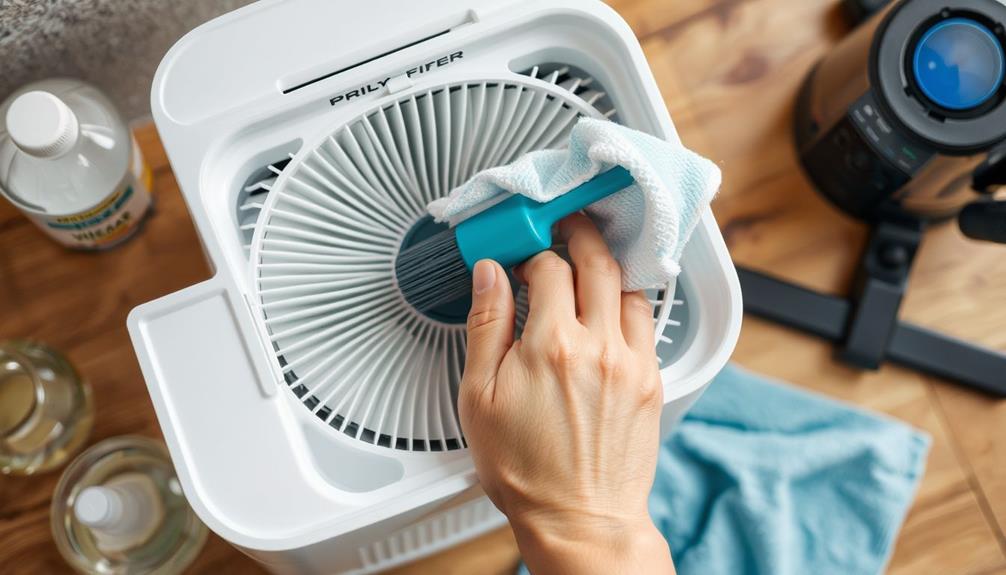
Cleaning your air purifier can be straightforward, but certain mistakes can undermine its effectiveness and safety. First, always unplug your air purifier before cleaning. This simple step can prevent electric shock and potential damage to the unit.
When it comes to the filters, avoid using detergents, solvents, or essential oils; these substances can degrade the filter materials and considerably reduce their effectiveness. To further enhance your indoor air quality, consider incorporating mindful eating practices into your lifestyle, as they can complement the benefits of using an air purifier.
If you have washable HEPA filters, don't soak them in water for extended periods. Doing so can cause structural damage, which will hinder air purification. Additionally, when vacuuming non-washable HEPA filters, be gentle. Aggressive vacuuming can tear or damage the filter media, compromising air quality.
Another common mistake is placing carbon filters in damp areas or exposing them to moisture. This can lead to odor retention and reduced filtration efficiency.
Proper maintenance of your air purifier is crucial, so keep these tips in mind. By avoiding these cleaning mistakes, you'll guarantee your air purifier remains effective and functions at its best, providing you with clean air for a healthier environment.
Conclusion
In the grand symphony of indoor air quality, your air purifier plays an essential note. By regularly cleaning it, you're not just maintaining an appliance; you're conducting a healthier environment for your home. With the right tools and techniques, you can guarantee it performs like a maestro. So, avoid the common pitfalls, and let your air purifier shine like a star in the night sky, delivering fresh air for you and your loved ones to breathe easy.
